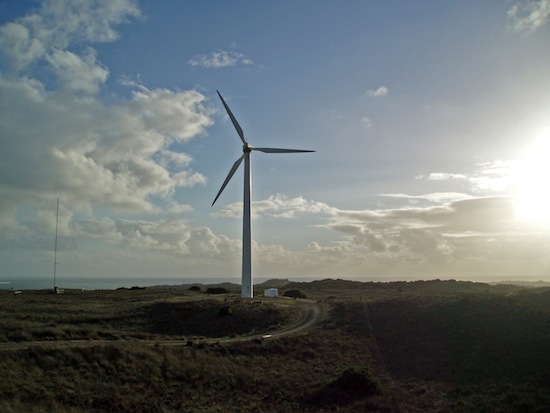Renewable energy is making progress, but it’s no replacement for fossil fuel. [4 December 2012 | Peter Boyer]

A wind turbine on King Island, part of the community’s existing windfarm.
Good news, it would seem. Within 40 years, according to Australia’s Climate Commission, “the Australian economy could be powered almost entirely by renewable energy”.
Last week the commission released its latest report, Generating a Renewable Australia. It’s a mixture of carrots — positive messages about Australia’s excellent potential to exploit renewable power — and sticks, in the form of dire warnings about rising global carbon emissions.
To prevent global temperatures from rising more than 2C (itself not a very nice place to be, let alone any warmer), the report says we need our carbon emissions to be “very near zero” within a mere 38 years, by 2050.
This is eminently achievable, it says: Australia is under-utilising a huge renewable potential which, with enough effort, could be used to power almost the entire Australian economy.
It’s a message that resonates powerfully around climate action circles, aided by seductive imagery of gleaming high-tech equipment: windmills on grassy knolls and solar panels on sunny rooftops.
Australians who can afford it are voting with their money. The installed capacity of rooftop solar in Australia multiplied 14 times in just two years from 2008, and the rate continues to rise. By July this year over 750,000 Australian households and businesses had installed solar panels.
They’re still doing it as panel prices continue to drop, apparently undeterred by climate minister Greg Combet’s announcement three weeks ago that federal subsidies for solar installation would end from January next year, six months early.
Australia’s wind energy sector is growing faster than any other large-scale generation source, at an average of 40 per cent a year in the five years to 2010. Over a quarter of South Australia’s electricity is now generated by wind.
With its hydro system already providing the bulk of Australia’s renewable energy capacity, Tasmania too is looking to wind. Last week Hydro Tasmania floated plans for a $2 billion, 200-turbine farm — it would be the country’s biggest — on breezy King Island.
The Climate Commission’s firm support for development of wind, solar, wave and tidal energy technologies continues a line of argument that over the past decade or so has become identified with a sustainable future.
I’ve played my part in this. Years ago, as a novice on the climate campaign trail, I remember wondering whether it mightn’t be sensible for governments simply to pay for a photovoltaic solar array on every Australian rooftop.
Over time I became aware of misgivings about such direct action. Far more cost-effective than doling out freebies, say the economists, is for governments to put a price on carbon and leave it to the market to force up the cost of generating fossil-fuelled energy.
But the experience of European carbon pricing is that although it may help, it isn’t enough. We still need “complementary measures” to encourage people to use less fossil energy. Better building insulation is one obvious answer; another would seem to be renewable energy.
Renewables go down well in a society driven by consumerism. People lucky enough to have disposable income get a far better financial return from investing it in solar panels than in a McMansion or a racy runabout, recouping the outlay over time with lower power bills.
But we’re kidding ourselves if we think such alternative technologies can completely, seamlessly replace today’s fossil fuels.
Oil and coal became popular energy sources for a good reason — they have a huge, almost miraculous, power-to-weight ratio that translates into cheap and abundant energy. We grew up on that energy and have become a bit ho-hum about it. We shouldn’t have.
It’s becoming cheaper to generate electricity from the sun and wind because the equipment is being mass-produced using plentiful, cheap fossil energy from coal and oil.
Today’s solar and battery technologies make it feasible, at a price, to go “off-grid”. But this is possible only because whole countries are “on grid” and deploying complex refining and manufacturing processes. Could you make a solar panel? I don’t think so.
Today’s renewable technologies are not a straightforward replacement for the fossil energy we’ve grown accustomed to. If we’re to wean ourselves off these addictive substances we’re going to have to learn to live with less.
Living with less doesn’t go down well in most circles, which is why both government and opposition avoid it like the plague and why the Climate Commission seeks to be upbeat about our renewable future.
But one day we’ll have to confront the reality of a lower-energy future, and the sooner the better.
.
• IN WRITING this article I was very conscious of my debt to John Evans, late of Dunalley, fisherman, amateur scientist and deep thinker whose untimely death on November 22 aged 63 ended a lifelong personal effort to persuade his fellow-citizens to live within Earth’s natural limits.One of his main targets was government accountability. His regular brushes with authority tested government agencies to the limit and sometimes beyond, and made him the bane of many a bureaucrat.
John phoned me often for a chat, our conversations ranging over such things as the limits of energy and humanity’s failure to “get it”. His inquiring mind and hard practical experience greatly illuminated my own understanding of nature at work. I will miss him sorely.
